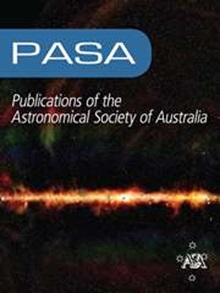FRB 20171020A的宿主星系被重新观测
IF 4.6
3区 物理与天体物理
Q1 ASTRONOMY & ASTROPHYSICS
Publications of the Astronomical Society of Australia
Pub Date : 2023-05-29
DOI:10.1017/pasa.2023.27
引用次数: 1
摘要
FRB 20171020A的假定宿主星系于2018年首次被确定为ESO 601-G036,但由于没有检测到重复爆发,因此直接确认宿主星系仍然难以捉摸。鉴于该领域最近的发展,我们重新审视这个宿主,并确定一个新的协会置信水平为98%. At 37 Mpc, this makes ESO 601-G036 the third closest FRB host galaxy to be identified to date and the closest to host an apparently non-repeating FRB (with an estimated repetition rate limit of $<$ $0.011$ bursts per day above $10^{39}$ erg). Due to its close distance, we are able to perform detailed multi-wavelength analysis on the ESO 601-G036 system. Follow-up observations confirm ESO 601-G036 to be a typical star-forming galaxy with H i and stellar masses of $\log_{10}\!(M_{\rm{H\,{\small I}}} / M_\odot) \sim 9.2$ and $\log_{10}\!(M_\star / M_\odot) = 8.64^{+0.03}_{-0.15}$ , and a star formation rate of $\text{SFR} = 0.09 \pm 0.01\,{\rm M}_\odot\,\text{yr}^{-1}$ . We detect, for the first time, a diffuse gaseous tail ( $\log_{10}\!(M_{\rm{H\,{\small I}}} / M_\odot) \sim 8.3$ ) extending to the south-west that suggests recent interactions, likely with the confirmed nearby companion ESO 601-G037. ESO 601-G037 is a stellar shred located to the south of ESO 601-G036 that has an arc-like morphology, is about an order of magnitude less massive, and has a lower gas metallicity that is indicative of a younger stellar population. The properties of the ESO 601-G036 system indicate an ongoing minor merger event, which is affecting the overall gaseous component of the system and the stars within ESO 601-G037. Such activity is consistent with current FRB progenitor models involving magnetars and the signs of recent interactions in other nearby FRB host galaxies.本文章由计算机程序翻译,如有差异,请以英文原文为准。
The host galaxy of FRB 20171020A revisited
Abstract The putative host galaxy of FRB 20171020A was first identified as ESO 601-G036 in 2018, but as no repeat bursts have been detected, direct confirmation of the host remains elusive. In light of recent developments in the field, we re-examine this host and determine a new association confidence level of 98%. At 37 Mpc, this makes ESO 601-G036 the third closest FRB host galaxy to be identified to date and the closest to host an apparently non-repeating FRB (with an estimated repetition rate limit of
$<$
$0.011$
bursts per day above
$10^{39}$
erg). Due to its close distance, we are able to perform detailed multi-wavelength analysis on the ESO 601-G036 system. Follow-up observations confirm ESO 601-G036 to be a typical star-forming galaxy with H i and stellar masses of
$\log_{10}\!(M_{\rm{H\,{\small I}}} / M_\odot) \sim 9.2$
and
$\log_{10}\!(M_\star / M_\odot) = 8.64^{+0.03}_{-0.15}$
, and a star formation rate of
$\text{SFR} = 0.09 \pm 0.01\,{\rm M}_\odot\,\text{yr}^{-1}$
. We detect, for the first time, a diffuse gaseous tail (
$\log_{10}\!(M_{\rm{H\,{\small I}}} / M_\odot) \sim 8.3$
) extending to the south-west that suggests recent interactions, likely with the confirmed nearby companion ESO 601-G037. ESO 601-G037 is a stellar shred located to the south of ESO 601-G036 that has an arc-like morphology, is about an order of magnitude less massive, and has a lower gas metallicity that is indicative of a younger stellar population. The properties of the ESO 601-G036 system indicate an ongoing minor merger event, which is affecting the overall gaseous component of the system and the stars within ESO 601-G037. Such activity is consistent with current FRB progenitor models involving magnetars and the signs of recent interactions in other nearby FRB host galaxies.
求助全文
通过发布文献求助,成功后即可免费获取论文全文。
去求助
来源期刊
CiteScore
5.90
自引率
9.50%
发文量
41
审稿时长
>12 weeks
期刊介绍:
Publications of the Astronomical Society of Australia (PASA) publishes new and significant research in astronomy and astrophysics. PASA covers a wide range of topics within astronomy, including multi-wavelength observations, theoretical modelling, computational astronomy and visualisation. PASA also maintains its heritage of publishing results on southern hemisphere astronomy and on astronomy with Australian facilities.
PASA publishes research papers, review papers and special series on topical issues, making use of expert international reviewers and an experienced Editorial Board. As an electronic-only journal, PASA publishes paper by paper, ensuring a rapid publication rate. There are no page charges. PASA''s Editorial Board approve a certain number of papers per year to be published Open Access without a publication fee.

 求助内容:
求助内容: 应助结果提醒方式:
应助结果提醒方式:


